Royal duty was to marry a spouse who would bring a strong alliance, wealth, and influence—it was rare to ever actually fall in love. Yet for some lucky royal couples, there was the opportunity to do both; for some, love even took took precedence. If you’ve heard enough about King Henry VIII’s many wives or the turbulent relationship between Princess Diana and King Charles III, consider these 10 lesser known royal love stories.
1. Judith, Queen of Wessex and Count Baldwin
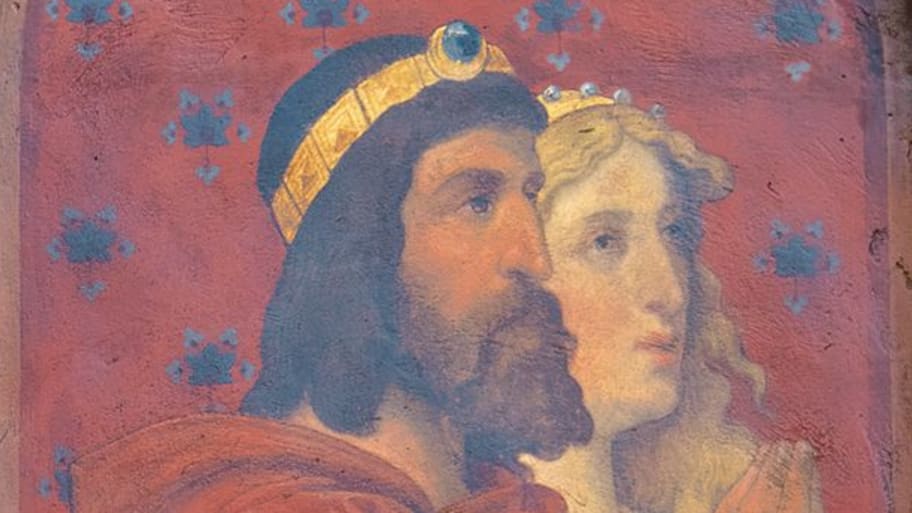
Count Baldwin and Judith. | Jan van der Asselt, Wikimedia Commons // Public Domain
Before England came into being in 927, it was made of smaller kingdoms, one of which was Wessex, located on the southern coast. Like most of northern Europe at this time, Wessex was vulnerable to Viking attacks; its king, Æthelwulf, sought an alliance to protect it. He wed Judith—the 12-year-old daughter of Charles II, the King of West Francia (now part of France)—in October 856.
Judith’s status as a member of the powerful Carolingian family meant her marriage also made her the first woman to be anointed as Queen of Wessex. But when her new husband died just two years later, his son, Æthelbald, took her as his own wife in an act a contemporary chronicler described as “against God’s prohibition and Christian dignity, and also contrary to the practice of all pagans” and that it “incurr[ed] great disgrace from all who heard of it.”
Æthelbald also died two years later. Judith, now a widow for the second time at just 16, returned to West Francia. Her father placed her in a religious house, a fate most Carolingian princesses suffered. But Judith was not prepared to settle for life as a nun.
Count Baldwin’s background is unknown, but he may have met Judith before her first marriage. He certainly knew her by Christmas 861, when the two eloped with the consent of her brother, Louis (some sources say Judith was kidnapped; others say she married Baldwin willingly). Charles II didn’t approve of the match. Despite an extensive search—and having Baldwin excommunicated—the West Francian king was unable to find Baldwin and Judith. The two escaped and made their way to Rome. Only the threat that Baldwin would join forces with the Vikings led Charles II to forgive them.
The couple returned to West Francia in 863, where Baldwin was made Margrave of Flanders. He and Judith ruled the southern territory successfully for at least the next seven years, repelling Viking attacks and remaining loyal to the Francian kings. While Baldwin is known to have died in 879, Judith’s fate is unrecorded.
2. Edward I and Eleanor of Castile
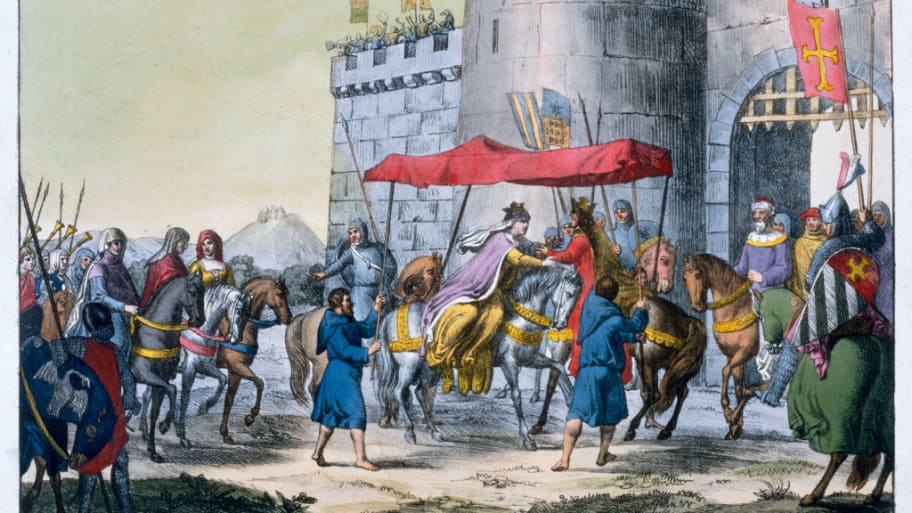
The wedding of Edward I and Eleanor of Castile. | Heritage Images/GettyImages
Edward I is remembered in history as a warrior. But he was also a passionate and faithful husband, so in love with his wife, Eleanor of Castile, that he created some of the most endearing monuments to love in England.
Edward I was 15 and Eleanor 13 when they married in November 1254. Like all medieval royal marriages, the union was arranged by their fathers. Eleanor gave birth to a daughter just nine months after they wed. During their marriage they were rarely apart, even when Edward I went on crusade to the Holy Land or military campaign to Wales. Although Eleanor was unpopular in England, Edward I was fiercely protective of her; she gave birth to another seven children before becoming queen in 1272, and a further eight after. Only one of their five sons would reach adulthood: the doomed Edward II.
In November 1290, Eleanor died at age 49 of complications resulting from malaria in the village of Harby. Edward I was with her. He was so utterly devastated that government business ground to a halt for the next three days. Eleanor’s body was transported back to London, and Edward arranged for a cross to be built at each of the 12 places her cortege stopped at overnight, three of which still survive. That January he wrote to Abbot of Cluny about his wife “whom in life we dearly cherished, and whom in death we cannot cease to love.”
3. Joan of Acre and Ralph de Monthermer
Joan was Edward I and Eleanor’s seventh child, born in Acre in the Holy Land in 1272 and brought up by her maternal grandmother in Ponthieu. As a daughter of a king, her marriage was always going to be made for dynastic reasons; in 1290 she married her father’s most powerful baron, Gilbert de Clare, Earl of Gloucester. She was 18 and he was 47.
The couple had four children before the earl died in 1295. After his death, Joan became close with her late husband’s Welsh squire, Ralph de Monthermer. It would have been forbidden for Joan to communicate with a man so far below her rank, but that didn’t stop them from marrying in secret sometime before January 1297. This was a dangerous move. Joan was still the daughter of a king, and he was already planning a second dynastic marriage for her to Amadeus V, Count of Savoy. Not only had she gone against protocol, but she had humiliated her father.
De Monthermer was imprisoned and Joan’s lands were forfeited to the crown, but she stayed loyal to her husband and was able to persuade her father to accept the marriage. On his release, de Monthermer was raised to the earldom of Gloucester in his wife’s stead and became a loyal supporter of his father-in-law. Joan gave birth to their first child in October 1297. She had two more kids before dying in 1307 at the age of 35.
4. Edward, Prince of Wales, and Joan of Kent
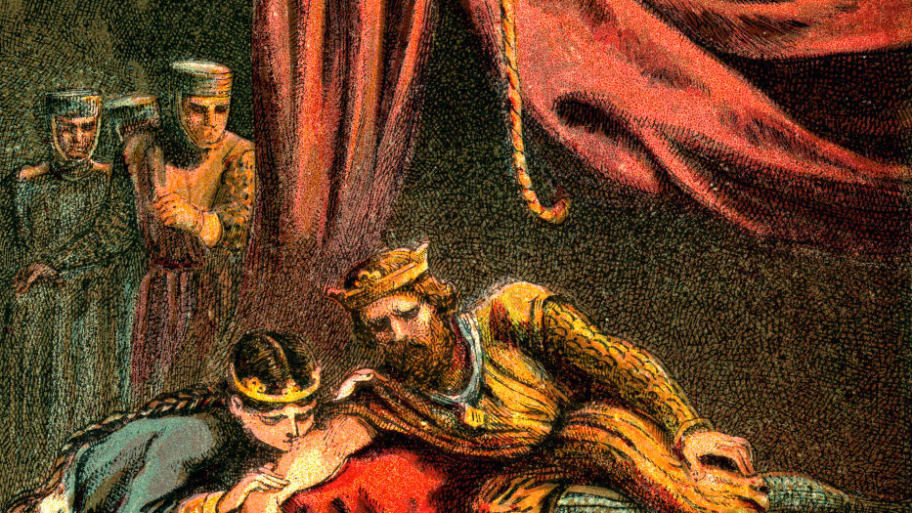
The Black Prince and Joan of Kent. | Print Collector/GettyImages
Joan of Kent, granddaughter of Edward I, seems to have inherited the same independent spirit as her aunt, Joan of Acre. She would have known her cousin Edward the Black Prince (son of Edward III) since she was a child, but he was not her first choice of husband. In the Spring of 1340, at the age of 13, she secretly married Sir Thomas Holland without the king’s permission before then entering into a bigamous marriage to William Montagu, Earl of Salisbury. It was not until 1349 that the situation was clarified and Joan was declared Holland’s legal wife. Joan became the Countess of Kent in her own right in 1352 and remained with Holland until his death in December 1360.
If the Black Prince had been secretly in love with his cousin, he now made his move. Despite ongoing negotiations for his marriage to Margaret of Flanders, within four months he had wooed and won Joan. She was certainly wealthy, though her disputed marital arrangements risked any offspring they had being declared illegitimate. But Edward was in love and spent the next six months petitioning the Pope into granting them a dispensation to marry before paying a large sum of money to the church. They were finally wed in October 1361.
Edward wrote Joan love letters from the battlefield, and the Chandos Herald recorded them publicly walking hand-in-hand [PDF]. When the Black Prince died in 1376, the Herald recorded that “the lovely and noble Princess felt such grief at heart that her heart was nigh breaking. Of lamentation and sighing, of crying aloud and sorrowing, there was so great a noise that there was no man living in the world, if he had beheld the grief, but would have had pity at heart.” Their son became Richard II a year later.
5. Henry IV and Joan of Navarre
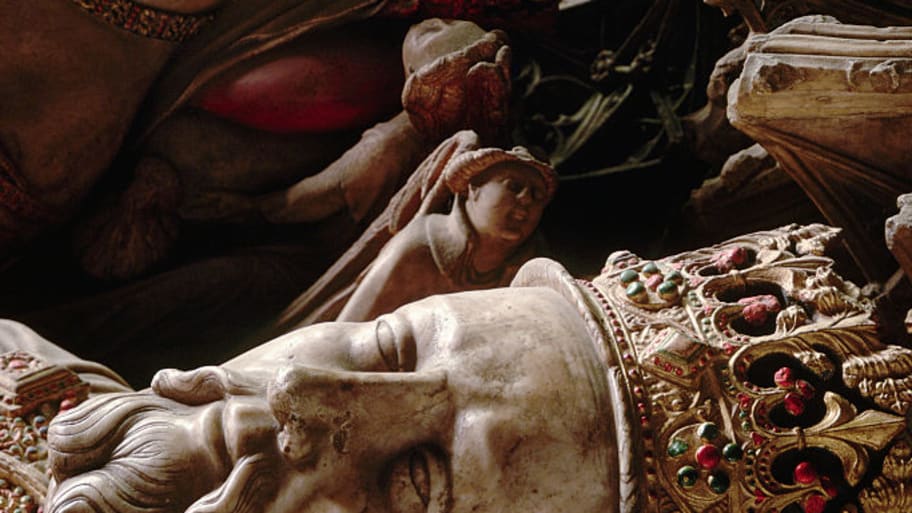
Effigies of King Henry IV and Joan of Navarre. | Angelo Hornak/GettyImages
It is highly probable that Henry of Lancaster and Joan of Navarre first met when she traveled to England to attend Richard II’s wedding in 1396. He was then a widower, but Joan came with her husband, John IV, Duke of Brittany, whom she had married in 1386.
Both experienced huge changes in 1399: October saw Henry IV become King of England, having usurped his cousin Richard II, and Joan’s husband died that November. The two remained in frequent contact for the next few years.
In March 1402, Joan sent an ambassador to England to negotiate their marriage. Henry IV accepted, despite the fact that the match offered little in the way of political or financial advantage. Similarly, Joan was forced to relinquish the regency and control of her sons. Six days later, the Pope granted them a dispensation to wed, and they were married by proxy within two weeks—an unprecedentedly short amount of time for a royal wedding.
Unlike many other medieval kings, Henry IV was faithful to his wife, and their mutual attraction was evident to contemporaries. Joan remained in England after his death in 1413 and chose to be buried beside him in Canterbury Cathedral in the tomb she had built for them both.
6. Dowager Queen Catherine and Owen Tudor
Catherine of Valois was the daughter of Charles VI, King of France, and came to England as the wife of Henry V in 1420. Henry V’s continuing war in France kept him away from her for most of their two-year marriage. The king died while on campaign, leaving 20-year-old Catherine a widow. Their son,Henry VI, was just 9 months old.
It did not take long for concerns to be raised about Catherine’s future. As the daughter and mother of a king, she could provide any second husband with unbridled influence and power. Parliament passed a statute that forbade her from marrying again without consent.
One chronicle recorded that Catherine was already suspected of being unable to “curb fully her carnal passions,” and sometime after 1428 she began a relationship with a Welsh squire named Owen Tudor. How and when they met is unknown. What is certain is that he was far below her in status and their affair was scandalous—so much so that it was kept a complete secret.
There is no record of their wedding and it’s possible that no one outside of her immediate household knew anything about it. Catherine and Tudor had at least four children, mostly kept away from court and raised in religious households, and even the dates of their births are unknown. Tudor made no attempt to influence the king through her, and his only reward was to be given the rights of an Englishman in 1432.
Catherine died shortly after the birth of her daughter in 1437. Henry VI ensured that his half-siblings were cared for and they, in turn, dedicated their lives to his service. Parliament even recognized them as legitimate, making them potential heirs to the throne. In 1485, Catherine and Tudor’s grandson became Henry VII—the first monarch of the Tudor dynasty.
7. Jacquetta of Luxembourg and Sir Richard Woodville
In 1433, aged 17, Jacquetta married 43-year-old John, Duke of Bedford, the brother of the late Henry V. At the time, the duke was heir presumptive to the English throne, making Jaquetta the second most important woman in England. But the duke died just two years later.
Jacquetta would have known Sir Richard Woodville for most if not all of her married life. He was a knight in her husband’s service, a lowly member of minor gentry and no match for the dowager duchess. Jacquetta knew that marriage to him would cause her trouble, as she was forbidden from marrying without Henry VI’s permission. Jacquetta and Woodville therefore wed in secret sometime before March 1437.
They spent the initial years of their marriage in France before returning to England, where the first of their 14 children, Elizabeth, was born sometime around 1437. Their fortunes fell when Henry VI was deposed in 1461, but the family was pragmatic and switched from supporting the House of Lancaster to the House of York during the Wars of the Roses. Their eldest daughter, Elizabeth, married Edward IV in a secret ceremony in 1464.
Jacquetta and Woodville now rose to prominence and made significant gains—and enemies. Jacquetta became a widow again in 1469 when Woodville and their son John were beheaded.
8. Cecily of York and Sir Thomas Kyme
Cecily was Jacquetta’s granddaughter, born in 1469. Her first marriage in 1485 was arranged by her uncle, Richard III, to Ralph Scrope; it was annulled a year later after the king’s fall. Her second marriage was again arranged, this time in 1488 to John, Viscount Welles, Henry VII’s uncle who was 20 years her senior. Despite it being a marriage to control Cecily’s claim to the throne through her father, it was a loving and happy union. His death in 1498 or 1499 left Cecily bereft.
Cecily returned to court in 1501 after a period of mourning and met Sir Thomas Kyme of Friskney, a Lincolnshire squire, sometime in the next two years. She was both still of marriageable age and a Yorkist princess, so any thoughts of marriage had political implications.
Cecily knew her affair with Kyme would ruin her chances of keeping her share of the Welles estates. But the two still married sometime between 1502 and 1504. As predicted, Henry VII immediately confiscated Cecily’s lands, though her husband seems to have avoided the inevitable imprisonment so many other men who had married without the king’s consent faced. That may have been due to the protection they received from the king’s mother, Margaret Beaufort, who was Cecily’s sister-in-law through prior marriage to Welles. Cecily negotiated a truce with the king and the couple moved away from court. They remained together until Cecily died in 1507.
9. James II and Anne Hyde
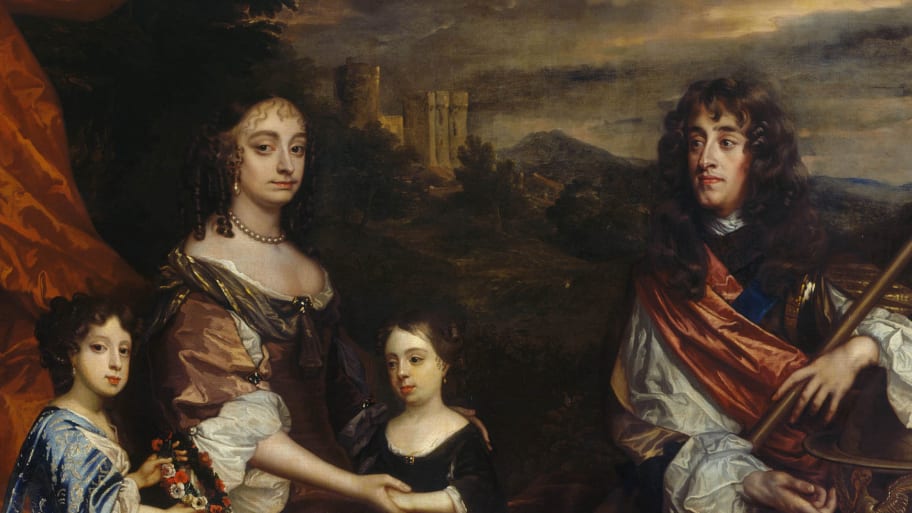
James II, Anne Hyde, and their two daughters. | Royal Collection , Wikimedia Commons // Public Domain
James II’s childhood was marked by the Wars of the Three Kingdoms, during which his father (Charles I) lost his head. In 1648, aged 15, he escaped England and lived in exile as his brother Charles II’s heir presumptive. Although at that time it seemed unlikely that they would ever return to England, his choice of wife was still an important decision—and not one to be made lightly.
The choice James made, however, was not what anyone expected. Anne Hyde was the daughter of his late father’s advisor. She lived at the court of James’s sister Mary, Princess of Orange. The court was notorious for its flirtatious and immoral behavior; Hyde was popular and known for her fun sense of humor, with one chronicler claiming that “there were none at the court of Holland who eclipsed her.”
Hyde went to Paris with Princess Mary to see the princess’s mother, Dowager Queen Henrietta Maria, in1656. Her father had tried to persuade her not to go—the queen did not like their family—but Hyde went nonetheless. It was there she met James II, who later pledged to marry her.
Hyde was pregnant when the two returned to England after the restoration of the monarchy. When their secret engagement was revealed, her father urged King Charles II to imprison her. But the king, although angry, insisted that Hyde would be a good influence on James II, saying he was “confident that naughty people which had too much credit with his brother and which had so often misled him, would be no more able to corrupt him, but that she would prevent all ill and unreasonable attempts, and therefore he again confessed that he was glad of it.”
Hyde and James were married in September 1660. James was not faithful, but he never sought to divorce her.
10. George VI and Elizabeth Bowes-Lyon
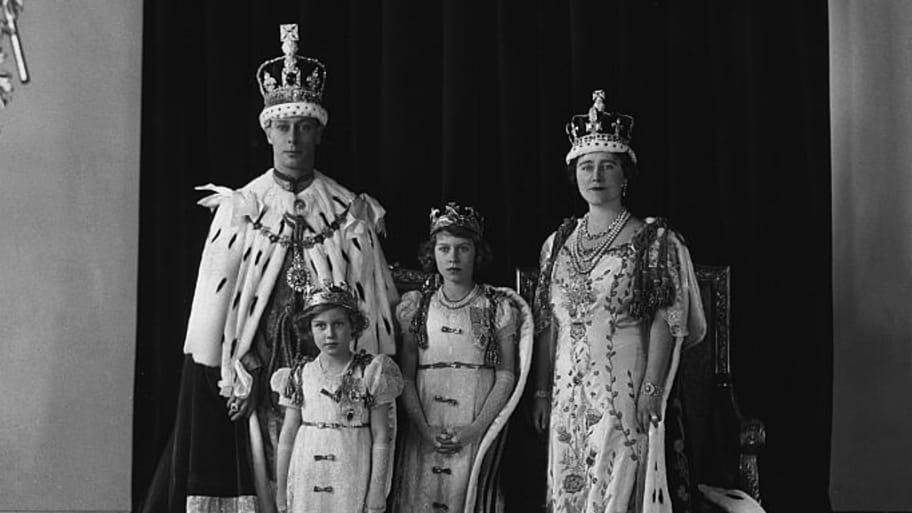
King George VI, Queen Elizabeth, Princesses Elizabeth, and Princess Margaret. | Hulton Deutsch/GettyImages
Elizabeth Bowes-Lyon was born in August 1900 to the Scottish Earl of Strathmore and Kinghorne. She had a privileged and loving childhood and developed her trademark charm and sense of fun at an early age. The future George VI—then known as Albert, Duke of York, or simply Bertie—however, was notably the opposite: He was shy, reserved, and had a stammer that made him self-conscious.
Bowes-Lyon and Bertie first met in June 1920 at a London society dance where, the latter later said, he immediately fell in love with her. Bowes-Lyon was being courted by numerous eligible men. Even so, the then-Duke of York was determined to get to know her better and would take frequent trips up to Glamis Castle in Scotland to see her. By February 1920, he was ready to propose.
An offer from a royal duke was probably better than her parents could have ever hoped for, but Bowes-Lyon turned him down. The Duke of York wasn’t deterred. He and his mother went to Glamis in September; Queen Mary was immediately taken with her and wrote that she was now sure that this was “the one girl who could make Bertie happy.”
However, the queen refused to interfere, and Bowes-Lyon and the Duke of York didn’t meet again until his sister’s wedding in February 1922. He asked her to marry him once more in March, but she refused him again. In January 1923 a newspaper reported that Bowes-Lyon was about to be engaged to his older brother, the Prince of Wales and heir to the throne. Although untrue, it may have been this that spurred Bertie to ask Bowes-Lyon to marry him one last time.
Fortunately, she accepted. Bowes-Lyon’s mother recalled that even then she was “torn between her longing to make Bertie happy and her reluctance to take on the big responsibilities which this marriage must bring.”
Neither could have anticipated just how big those responsibilities would be. In 1936, Edward VIII abdicated and the Duke of York became George VI. Bowes-Lyon wrote that “We are so particularly together, leaning so much on each other,” a devotion they would continue until his death in 1952.
This article was originally published on mentalfloss.com as 10 Lesser-Known Royal Love Stories.
News Related-
Russian court extends detention of Wall Street Journal reporter Gershkovich until end of January
-
Russian court extends detention of Wall Street Journal reporter Evan Gershkovich, arrested on espionage charges
-
Israel's economy recovered from previous wars with Hamas, but this one might go longer, hit harder
-
Stock market today: Asian shares mixed ahead of US consumer confidence and price data
-
EXCLUSIVE: ‘Sister Wives' star Christine Brown says her kids' happy marriages inspired her leave Kody Brown
-
NBA fans roast Clippers for losing to Nuggets without Jokic, Murray, Gordon
-
Panthers-Senators brawl ends in 10-minute penalty for all players on ice
-
CNBC Daily Open: Is record Black Friday sales spike a false dawn?
-
Freed Israeli hostage describes deteriorating conditions while being held by Hamas
-
High stakes and glitz mark the vote in Paris for the 2030 World Expo host
-
Biden’s unworkable nursing rule will harm seniors
-
Jalen Hurts: We did what we needed to do when it mattered the most
-
LeBron James takes NBA all-time minutes lead in career-worst loss
-
Vikings' Kevin O'Connell to evaluate Josh Dobbs, path forward at QB
